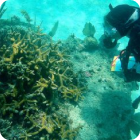
By: Kyle Grammatica
As hurricane season officially begins, it is important to ensure that you and your family are prepared. The impact of hurricanes on our communities is obvious, but their effect on the environment is also profound.
Hurricane Fish Kills
Hurricanes often lead to an increase in fish kills due to:
- Changes in salinity – Freshwater flooding from rain or saline storm surge may trap fish in water with inappropriate salinity. If this happens rapidly and the fish have no escape, species that are intolerant to salinity changes may die.
- Strandings from flooding – Rising waters may flood areas that do not normally contain water. Fish may become trapped in these areas, and when the water levels recede, they may be stranded.
- Low dissolved oxygen – When oxygen levels in the water get too low, fish are unable to obtain the required amount necessary for metabolism. Several factors can cause this condition including “turnover” and long periods of cloudy days.
- Turnover – In small lakes or ponds, strong winds may push surface water to one side of the lake. Water from the bottom then comes up to fill in space at the surface, bringing sediments and organic material with it. The water from the bottom is naturally low in oxygen, and the materials brought to the surface may include hydrogen sulfide, which in high concentrations can kill fish. Bacteria is also brought to the surface and begins decomposing the organic material, using up oxygen in the process. This is called “turnover” since the bottom literally becomes the top.
- Long periods of cloudy days – Microscopic organisms and aquatic plants produce oxygen for aquatic ecosystems through photosynthesis. This process requires energy from sunlight to complete, and long periods of cloudy days caused by hurricanes can prevent photosynthesis. Without photosynthesis, oxygen levels can be quickly depleted killing fish as a result.
Other Environmental Effects
Hurricanes’ environmental effects go beyond fish kills. Strong winds and flooding can uproot plants and kill land animals, devastating natural areas. Hurricanes may also destroy energy and chemical production facilities, gas stations, and other businesses, causing the release of toxic chemicals and pollutants into the environment. Hurricanes have also been known to spread invasive plants and animals. Wind and water can move exotic plants to new locations and invasive fish that were concentrated in a small area may ride floods to new locations and increase their range. Hurricanes have also destroyed breeding facilities of exotic species like Burmese pythons, allowing the animals to escape and become established in the wild.
The Foundation works to address both the societal and environmental losses caused by hurricanes. In the aftermath of Hurricanes Irma and Michael we gave over $250,000 for relief and recovery efforts. Support our efforts to protect Florida’s wildlife by donating here. And check out FWC’s website for updates about wildlife and storms.












